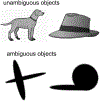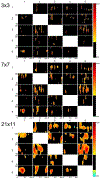Significance of event related causality (ERC) in eloquent neural networks
- PMID: 35248810
- PMCID: PMC9029701
- DOI: 10.1016/j.neunet.2022.02.002
Significance of event related causality (ERC) in eloquent neural networks
Abstract
Neural activity emerges and propagates swiftly between brain areas. Investigation of these transient large-scale flows requires sophisticated statistical models. We present a method for assessing the statistical confidence of event-related neural propagation. Furthermore, we propose a criterion for statistical model selection, based on both goodness of fit and width of confidence intervals. We show that event-related causality (ERC) with two-dimensional (2D) moving average, is an efficient estimator of task-related neural propagation and that it can be used to determine how different cognitive task demands affect the strength and directionality of neural propagation across human cortical networks. Using electrodes surgically implanted on the surface of the brain for clinical testing prior to epilepsy surgery, we recorded electrocorticographic (ECoG) signals as subjects performed three naming tasks: naming of ambiguous and unambiguous visual objects, and as a contrast, naming to auditory description. ERC revealed robust and statistically significant patterns of high gamma activity propagation, consistent with models of visually and auditorily cued word production. Interestingly, ambiguous visual stimuli elicited more robust propagation from visual to auditory cortices relative to unambiguous stimuli, whereas naming to auditory description elicited propagation in the opposite direction, consistent with recruitment of modalities other than those of the stimulus during object recognition and naming. The new method introduced here is uniquely suitable to both research and clinical applications and can be used to estimate the statistical significance of neural propagation for both cognitive neuroscientific studies and functional brain mapping prior to resective surgery for epilepsy and brain tumors.
Keywords: Granger causality; Information flow; Multivariate autoregressive model; Neural networks interactions; Short-time direct directed transfer function; Time–frequency analysis.
Copyright © 2022 Elsevier Ltd. All rights reserved.
Conflict of interest statement
Declaration of Competing Interest The authors declare that they have no known competing financial interests or personal relationships that could have appeared to influence the work reported in this paper.
Figures









Similar articles
-
Recording human electrocorticographic (ECoG) signals for neuroscientific research and real-time functional cortical mapping.J Vis Exp. 2012 Jun 26;(64):3993. doi: 10.3791/3993. J Vis Exp. 2012. PMID: 22782131 Free PMC article.
-
Four-dimensional functional cortical maps of visual and auditory language: Intracranial recording.Epilepsia. 2019 Feb;60(2):255-267. doi: 10.1111/epi.14648. Epub 2019 Feb 1. Epilepsia. 2019. PMID: 30710356 Free PMC article.
-
Dynamics of large-scale cortical interactions at high gamma frequencies during word production: event related causality (ERC) analysis of human electrocorticography (ECoG).Neuroimage. 2011 Jun 15;56(4):2218-37. doi: 10.1016/j.neuroimage.2011.03.030. Epub 2011 Mar 16. Neuroimage. 2011. PMID: 21419227 Free PMC article.
-
How to establish causality in epilepsy surgery.Brain Dev. 2013 Sep;35(8):706-20. doi: 10.1016/j.braindev.2013.04.004. Epub 2013 May 15. Brain Dev. 2013. PMID: 23684007 Free PMC article. Review.
-
High-frequency gamma oscillations and human brain mapping with electrocorticography.Prog Brain Res. 2006;159:275-95. doi: 10.1016/S0079-6123(06)59019-3. Prog Brain Res. 2006. PMID: 17071238 Review.
Cited by
-
Lexicality-Modulated Influence of Auditory Cortex on Subthalamic Nucleus During Motor Planning for Speech.Neurobiol Lang (Camb). 2023 Jan 18;4(1):53-80. doi: 10.1162/nol_a_00086. eCollection 2023. Neurobiol Lang (Camb). 2023. PMID: 37229140 Free PMC article.
-
The dynamics of cortical interactions in visual recognition of object category: living versus nonliving.Cereb Cortex. 2023 Apr 25;33(9):5740-5750. doi: 10.1093/cercor/bhac456. Cereb Cortex. 2023. PMID: 36408645 Free PMC article.
-
Dynamic Causal Tractography Analysis of Auditory Descriptive Naming: An Intracranial Study of 106 Patients.Neuroimage. 2025 Aug 15;317:121319. doi: 10.1016/j.neuroimage.2025.121319. Epub 2025 Jun 19. Neuroimage. 2025. PMID: 40516665 Free PMC article.
References
-
- Akaike H (1974). New look at statistical-model identification. IEEE Transactions on Automatic Control, AC19(6), 716–723.
-
- Altes RA (1980). Detection, estimation, and classification with spectrograms. The Journal of the Acoustical Society of America, 67(4), 1232–1246. 10.1121/1.384165. - DOI
MeSH terms
Grants and funding
LinkOut - more resources
Full Text Sources
Medical

